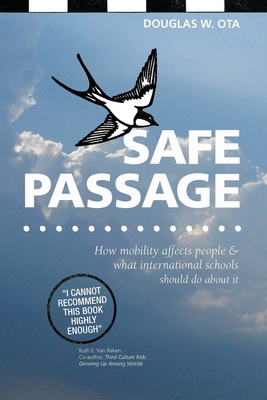 By Summertime author, Douglas W. Ota The real world gets reflected in our maps of the real world, not the other way around. Right? Simply putting something on a map won’t make it appear in the real world. Right? Wrong. Sometimes simply drawing something on a map does make it appear in the real world. This phenomenon can be put to use to change something about how international education works. To understand how, you’ll need some background. In a recent TED talk, John Greene, author of Paper Towns, explains the map-leading-to-reality phenomenon that gave his book its title. In 1937, the General Drafting Company published a map of New York State. To protect their intellectual property, they did what cartographers in those days did: they created a ‘map trap’ by placing a fictitious town, in this case the nonexistent town of ‘Agloe’, at the intersection of two dirt roads. Why? If that town appeared on any company’s later maps, the General Drafting Company would know the new map was a copy. Years later, Agloe appeared on Rand McNally’s newly published map of New York. General Drafting pounced. “You’re busted,” they declared triumphantly. “Agloe doesn’t exist! You copied our map!” “No we didn’t!” Rand McNally countered. “Agloe does exist!” Apparently, because Agloe was on a map, people started looking for it. Somebody built a general store to serve the people who were looking. At its height, Agloe had the general store, two houses, and even a gas station. A backward series of events, it would seem. But is the moral of the town of Agloe really so backwards? Do maps so rarely affect the real world? Or do our mental maps shape the real world in significant, pervasive ways? For thousands of years, philosophers have toyed with the notion that nothing in human creation exists until it first forms as an idea in somebody’s mind. The sacred Buddhist text Dhammapada begins with: We are what we think. All that we are arises with our thoughts. With our thoughts we create the world. In other words, to return to our mapping analogy, anything man-made must first make its way onto somebody’s map before it can appear in the real world. Allow me, then, to drop the seed of an idea onto the maps of our minds. Doing so may make an important idea take root in the world. But first grab your shovel. We need to prepare the soil. We need to change something about how international education works. It is true – and wonderfully so – that students who attend international schools are uniquely placed to make significant contributions to a better, more peaceful world. With their cross-cultural experience and expertise, our shrinking planet sorely needs these students. But mobility also challenges kids with repeated grief and loss. These fine international school students are only likely able to offer their gifts to the world if they are not overwhelmed by their experiences. And very, very few schools are doing anything to systematically address the challenges inherent in mobility. In my book Safe Passage: What Mobility Does to People and What International Schools Should Do About It, I explain why moving is a major life stressor and what schools can do about it. Beginning with the neuroscience behind how mobility strains our attachment systems, Safe Passage sequentially explains:
The last point – that no one school can deal with these issues on its own – resides in the fact that the emotional issues involved transcend individual school walls. By way of illustration, the way School A assists a boy in saying goodbye has a direct bearing on how he arrives at and feels at School B. And the way the boy eventually leaves School B has a bearing further downstream, in terms of how he arrives as he moves into, and through, School C. The only way to address this simple reality is if School A cares about how this student feels at School B. And School B needs to care about how things eventually work at School C. How in the world are we ever going to get something like that to happen? By asking that question, the soil has been prepared. Ready for the seed? Ready for the idea we might need to cause a town to form on the map? The time has come for Safe Passage schools to form. The time has come for an anxious parent, worried about yet another move, to be able to see the Safe Passage swallow stamp on a prospective school’s website – and to relax. She knows her kids will be welcomed and integrated. She knows she and her family will be welcomed and integrated. She knows when others leave her family behind, curricular programs to assist them with the grief will kick into place – and not be left to chance. And she knows when the time comes for her family to leave this future community, that process, too, will receive guidance, since leaving well forms the basis for arriving well at any subsequent school. In much the same way as the ‘green running man’ above every public doorway says run this way in case of fire, the time has come for a simple swallow stamp to convey a complex idea, namely that we care, we’re connected to other schools who care, and you can rest assured the challenges of mobility will be well taken care of at our school community. That’s my paper town, marked with a stamp. Care to visit? We need a general store. We need a gas station and a postal office. We need a movement. This is why you’re encouraged to attend the Families in Global Transition Conference in Amsterdam in March of 2017 (#FIGT17NL), where we’ll be hosting a first-ever Safe Passage Schools Pre-conference, to bring like-minded people together who are passionate about practically addressing this topic at schools. Interested? Drop me a line: [email protected]. And the goal of that Preconference is to lay the groundwork for a first-ever annual Safe Passage Schools Conference in March, 2018. Mark your calendars! Since we’re dreaming big – and in the spirit of launching this paper town towards its full potential potential – I would hope the Safe Passage stamp conveys even more to those who see it in 2026. I would hope, with one glance at that bird, parents, students, and staff would know that this Safe Passage school – like any Safe Passage school – cares about addressing mobility well, as it allows our teachers to get on with the business of teaching, our parents to get on with the business of parenting, and our students to get on with the business of learning and growing, all so that our fortunate students can contribute to a world where people are able and willing to genuinely understand and respect those from other walks of life.
|
�
All the latest news from the team at Summertime Publishing
As an Amazon Associate, we may earn a commission from qualifying purchases. This does not affect the price you pay or your consumer rights.
Archives
June 2024
|


